#Xylocopa virginica
Text

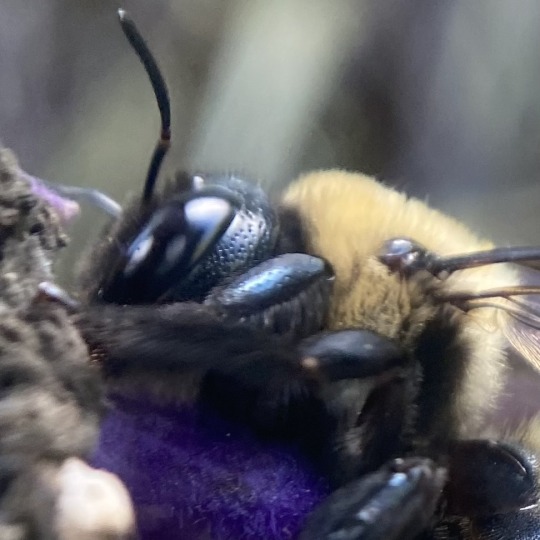
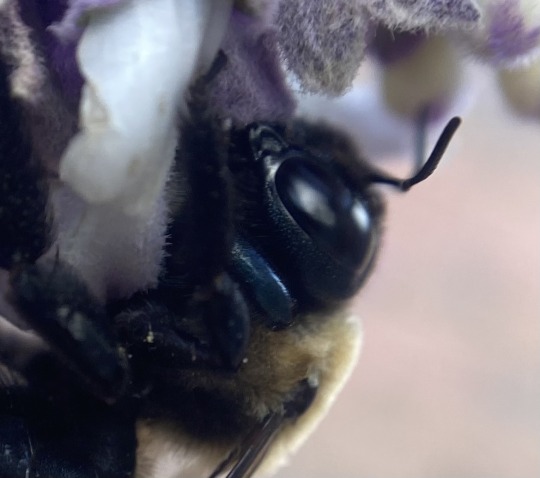

carpenter bee closeups
50 notes
·
View notes
Text

Eastern carpenter bee (Xylocopa virginica) in central Pennsylvania
#Xylocopa virginica#eastern carpenter bee#carpenter bee#bee#buzz buzz#hymenoptera#insect appreciation#nature photography#nature#bugs#biodiversity#animals#inaturalist#arthropods#entomology#insects#penn state botanical garden#penn state arboretum#pennsylvania wildlife#support native pollinators#pollinators#flowers#garden#natural beauty#purple#bugblr
10 notes
·
View notes
Text


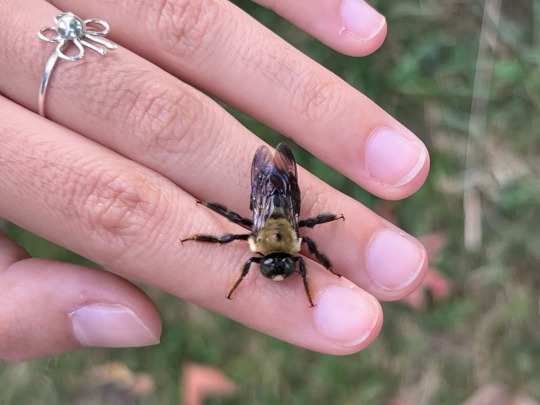
Xylocopa virginica
Eastern carpenter bee
24 of September 2022 — New York, USA
The most handsome man! This is a male carpenter bee. They can be distinguished from females because only males have a bright yellow patch in between the eyes, females have completely black faces.
Males that are interested in mating with the females will establish territories nearby and will defend it from other insects. Since only females can sting (as the stinger is a modified ovipositor, an egg-laying structure only found in females), what the male carpenter bee will do is fly around and BODY SLAM other insects, which is hilarious if you get to witness it.
Absolutely love these guys <3
#bugs#bugs i found#bee#bees#carpenter bee#Insecta#Hymenoptera#Apidae#Xylocopa#Xylocopa virginica#original content
14 notes
·
View notes
Text
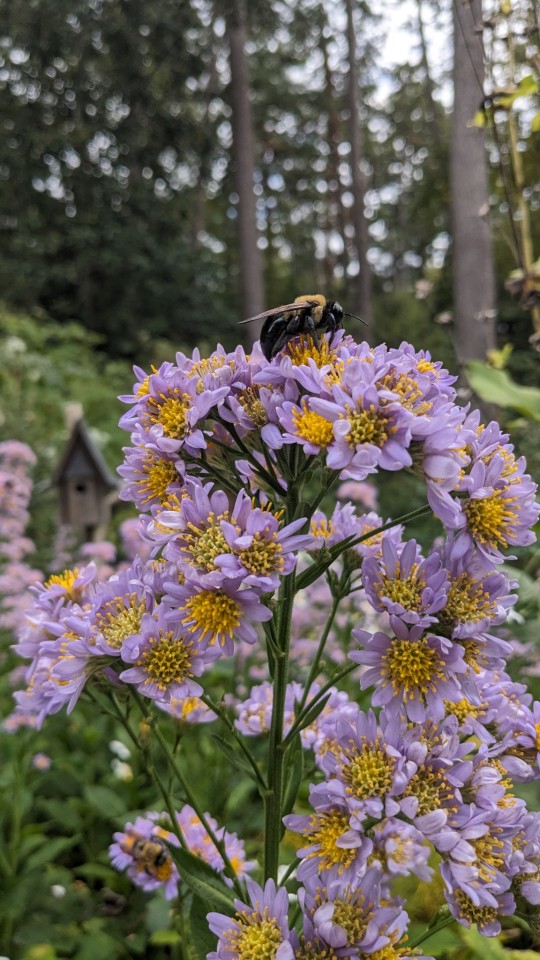
Xylocopa virginica on Aster tataricus 'Jin Dai' / Eastern Carpenter Bee on 'Jin Dai' Tartarian Aster at the Sarah P. Duke Gardens at Duke University in Durham, NC
#Xylocopa virginica#Xylocopa#Aster tataricus#Aster#Aster tataricus 'Jin Dai'#Jin Dai Tartarian Aster#Tartarian Aster#Native pollinators#Flowers#Nature photography#photographers on tumblr#Sarah P. Duke Gardens#Duke Gardens#Duke University#Durham#Durham NC#North Carolina#Carpenter Bee#Bee#Bees
1 note
·
View note
Text

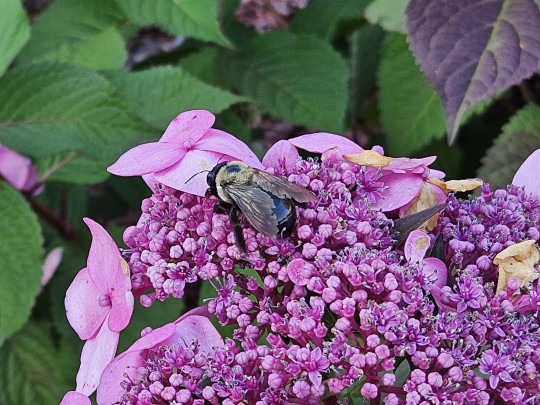
Carpenter bee (Xylocopa virginica), September 2023
Southwestern PA
1 note
·
View note
Text
#my personal favorite however is the#carpenter bee#specifically xylocopa virginica#theyre so big and stupid i love them#constantly ready to beef#love it#any answer is a good answer#unless you vote to squish them#then youre weird sorry bub#poll#bee#bees#bees.?#tumblr poll#insects#wasps#wasp#bugs#again theyre not legally bugs but ill tag it as such so if ppl have it blocked they wont see it#bug#pls reblog#i want attention and to know what people think about bees#i mean theres probably only two bees here that most people have heard of but if youre curious then google them!#theyre all special babes and interesting in their own way#like did you know that orchard mason bees are the most successful fruit tree pollinators in north america#hence the name#and theyre called orchard MASON bees bc they make their nests in hollow reeds and block it off with mud#well they lay their eggs in there and each egg gets its own section and cache of sustenance#each section blocked off by mud#theyre pretty interesting
24 notes
·
View notes
Text
ok everyone please follow my bug sideblog @xylocopavirginica :D
i will still post some bug things on my main blog of course because they make me happy but most of the irl pics or entomology focused posts will go on the sideblog. and i will post some of my own photos as well there!
AND if you have any bug questions or pics of bugs or identification requests please please send them to me i love to talk about bugs
#xylocopa virginica is the scientific name for the eastern carpenter bee#one of my favorite bees :)#snail.txt
8 notes
·
View notes
Text


this is o!tubbo to me. btw.
#bell.txt#osmp#sorry i dont know the exact species off the top of my head#i would guess theyre xylocopa virginica but idk#insects tw
5 notes
·
View notes
Text
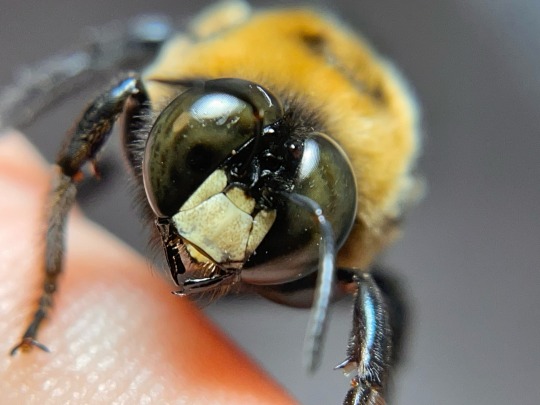
found a chunky male carpenter bee on his back in the rain & took him inside to warm up.
it worked too well and he was moving too quickly for nice photos!
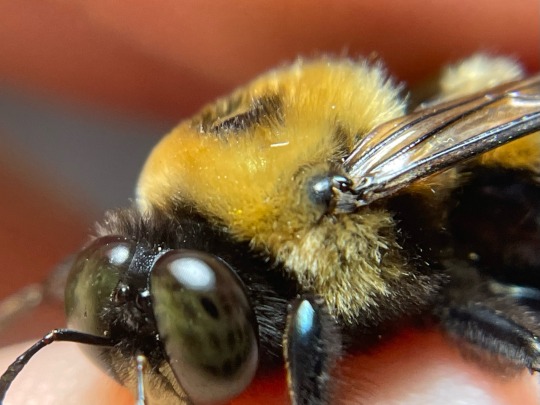

you’ll have to take my word for it that he was a wonderful velvety texture.
(Xylocopa virginica)
2K notes
·
View notes
Text
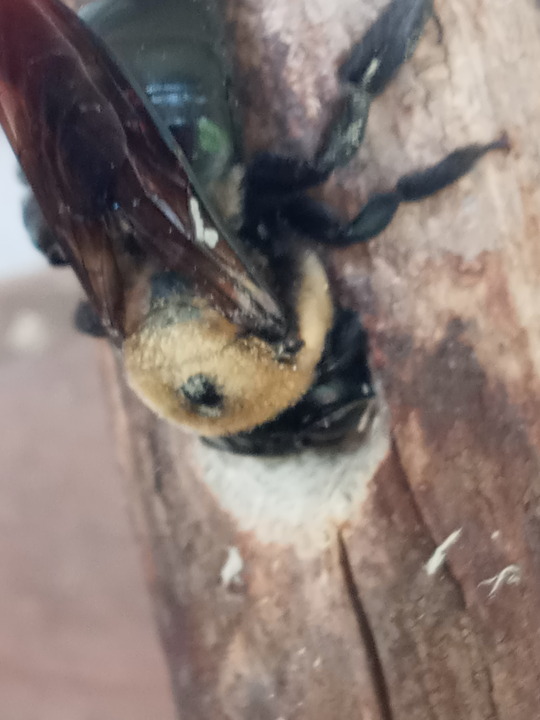
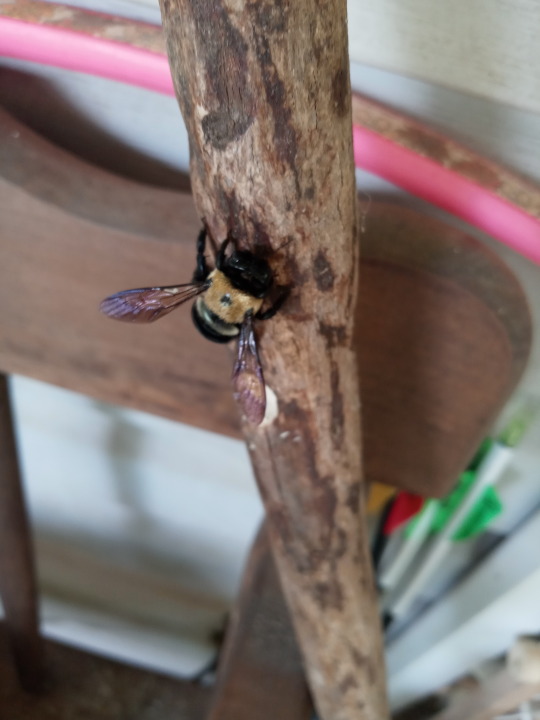
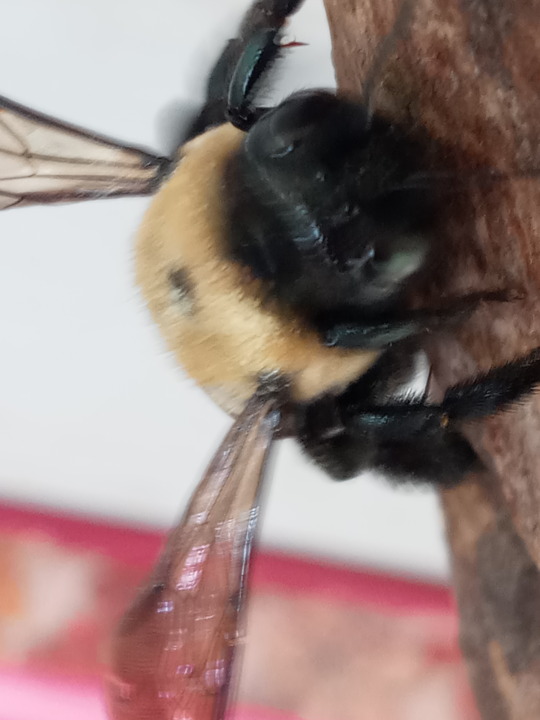



[VIDEO AND PHOTOS TAKEN: MAY 8TH, 2023 | Video and Image IDs: A video and six photos of a yellow and black eastern carpenter bee (Xylocopa virginica) crawling on and chewing a hole into a brown walking stick in front of a grey background and a few other objects /End IDs.]
#Bees#Bee#carpenter bee#Eastern Carpenter Bee#apidae#hymenoptera#bugs#bug#insect#insects#entomology#arthropods#invertebrate#photos#photo#Wasp House Sights
207 notes
·
View notes
Text





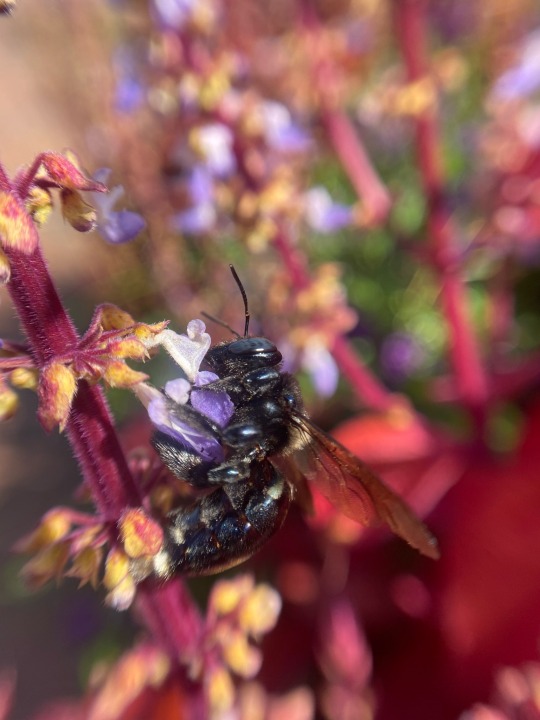
eastern carpenter bee
10 notes
·
View notes
Text
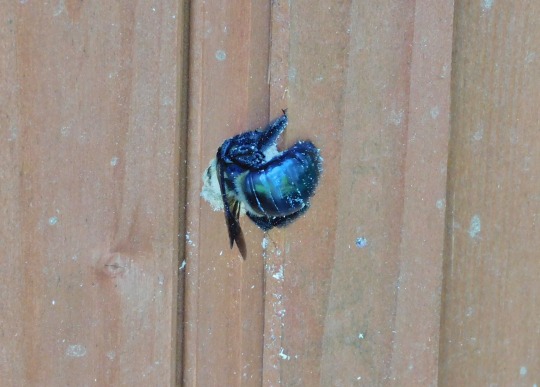



This particular Eastern Carpenter Bee (Xylocopa virginica) is about to be a very disappointed bee, as it has spent 2 solid days gnawing a tunnel into the thinnest part of the chicken coop door, and he will very soon be through into the nothingness...
#nature#my photography#carpenter bee#nature photography#bee#wildlife photography#insect#backyard nature
14 notes
·
View notes
Text
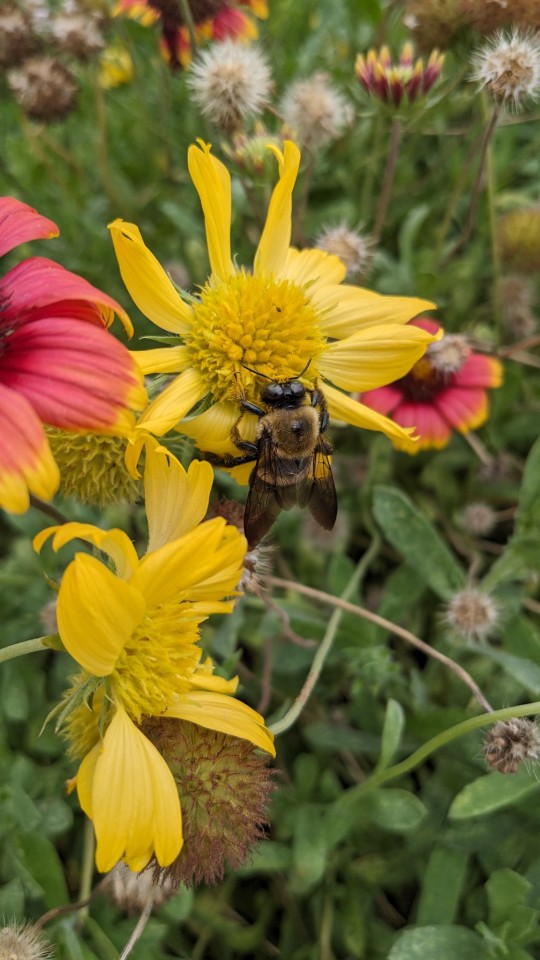
Xylocopa virginica on Gaillardia pulchella / Eastern Carpenter Bee on Blanket Flower
#Xylocopa virginica#Xylocopa#Gaillardia pulchella#Blanket Flower#Indian blanketflower#firewheel#Bee#Bees#Native pollinators#Native plants#Native flowers#Flowers#Nature photography#photographers on tumblr#Home
1 note
·
View note
Text

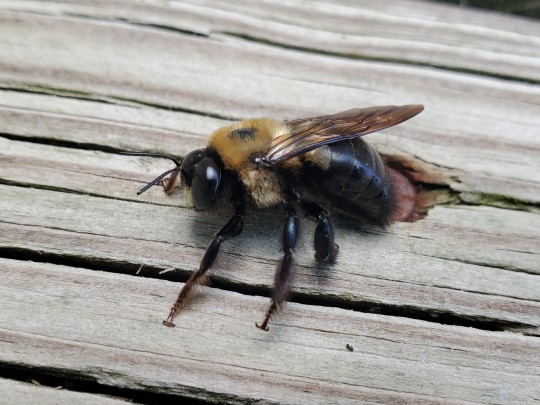
Eastern Carpenter Bee (male, white face marking), Xylocopa virginica
#eastern carpenter bee#carpenter bee#bee#arthropod#invertebrate#insect#bug#ID#saltmarsh bird survey job
41 notes
·
View notes
Text


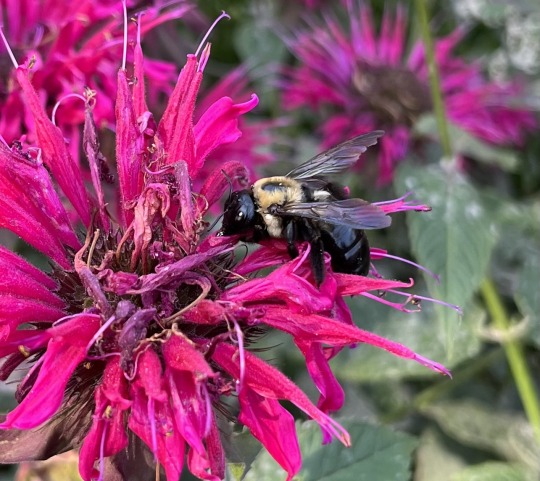
Xylocopa virginica - Eastern carpenter bee nectar robbing from scarlet bee balm. July 19, 2023
7 notes
·
View notes
Note
Hi, I’m also a NH resident - what can you tell me about the native bees that are here?
I know it’s a pretty general question, but I’ll take all the info dumping you’re willing to do
Thanks!
Readers, this is a long post, so feel free to press J and skip it if it's not for you. But if you live in the northeast it may be of interest!
Hiya fellow New Hampshirite! I could talk oodles about our native bees, especially since I did field research on them in undergrad and continue to work with native bees in the northeast, first for my MS and now in my job (upstate New York currently). The things I say here are broadly applicable to all of New England, as 1) this region is relatively homogenous in its bee fauna (melittofauna) given that it's temperate and has similar habitats (particularly in its high cover of hardwood forests and few grasslands), and 2) New Hampshire is poorly studied in terms of its bee diversity relative to other New England states, which I'll get to.
A bit of bee background
As you may or may not know, wild bees are nothing like honeybees. The vast majority of bees are solitary, not social, so they live singly in nests - either underground tunnels, or excavations in stems or wood, occasionally human structures - and in our area are generally univoltine, meaning they have one generation per year (this changes as you move further south in the US, sometimes even the same species switches to multivoltinism given a longer growing season). Solitary bees include everything from mining bees (Andrena), leafcutter bees (Megachile), mason bees (Osmia), cellophane bees (Colletes), longhorned bees (Melissodes), masked bees (Hylaeus), and many others. Our social bees - which comprises a wide spectrum from weakly social to primitively eusocial behavior (honeybees are 'advanced' eusocial) - include groups like carpenter bees (Xylocopa virginica, Ceratina), bumble bees (Bombus), and many metallic sweat bees (e.g., Lasioglossum). Many others are kleptoparasites, or brood parasites - a higher diversity than social bees actually. These do not collect pollen or build nests, rather they target a specific host bee species and lay their eggs in the host nest, where their larva eats all the pollen provisions meant for the host. These 'cuckoo bees' as they're called include nomad bees (Nomada), cuckoo sweat bees (Sphecodes, sometimes called blood bees though this is a misnomer as there are actual blood-feeding bees in the tropics), cuckoo leafcutter bees (Coelioxys), longhorn cuckoo bees (Triepeolus, Epeolus), and several others that are much less common.

Eight-toothed cuckoo leafcutter bee, Coelioxys octodentatus. It targets the nests of several species of leafcutter bee.
Bees collect pollen for their offspring. Most are generalists, visiting and collecting pollen from many families of flowering plants. But in our area, around 15% (this number is much higher in the southwest and other ephemeral/highly diverse habitats) of our bees are diet specialists, also known as oligolectic. They evolved to feed their young pollen from a specific group of plants, anything from one family (e.g., Asteraceae) to, commonly, one or a few related genera (e.g., Solidago) or rarely even one species (e.g., Macropis nuda on Lysimachia ciliata). In our area, these 'monoleges' are typically so because there's only one suitable representative of that plant group present in New England, but they may use more hosts further south (though, not always! We still have much to learn about the true specificity for these species, it's difficult to really know how specialized they are). True monoleges are more frequent in arid regions where there is a high proportion of endemic plants, and with it, endemic bees. Specialist bees often have adaptations to make them more efficient at collecting pollen from their hosts, and they tend to be more rare than generalists because they are only found with their host, which may have a patchy distribution, and are only out for a short period of time - as little as two weeks, when their host is flowering. A full list of known specialist bees in the eastern US and their hosts can be found here. Fowler (2016) is the peer-reviewed journal article version of this that is specifically for the northeast.
Bees in New Hampshire
New Hampshire probably has somewhere between 300-400 species of bees, based on estimates from surrounding states, the region as a whole (which is around 450), and museum records. I curate an ongoing project on iNaturalist to list all known bee species in the state, which you can see here. That has around 300 species (only 78 have actually been observed in NH on iNat), which is a hefty handful more than the few contemporary published surveys have found - entirely done by the Rehan Lab (now at York University), where I studied and worked for two years. Those surveys were centered in the southeastern portion of the state (Strafford Co, at and around UNH), the White Mountains, and in the Ossipee Pine Barrens. I helped with all of these surveys! They produced several new state records. The vast majority of historical bee collections by past naturalists were focused in the Durham area as well, making our idea of bees in the state very skewed and leaving vast swaths of the state, and many habitats, unexplored. This matters, because our state may seem a monolith of forest but it isn't!
Bee communities differ by geography, habitat, soils, and specific local plant composition. While New Hampshire doesn't quite have the diversity in ecoregions or plant species that some other states have (the southwest has around 800-1200 bee species per state), things do differ, and what we do have is special in its own right.
Geography: We sit at a boundary of north and south in terms of insect species, with northern New England representing the (current) northernmost range for some 'southern' species, and the southernmost range for 'northern' species in North America. In southern NH, you will likely find the same sort of bees that you'd find in Massachusetts, most of those also being found in New Jersey or even North Carolina, or as far west as the central states. That's how you end up with bees like Agapostemon texanus in New Hampshire! But in the north country, the composition of bees starts to change, with many more traditionally Canadian species becoming common. This is well-observed in bumble bees - around and north of the White Mountains, you really start to see more of the tricolored bumble bee (Bombus ternarius) and northern amber bumble bee (Bombus borealis, aptly named). The majority of our remaining population of the yellow-banded bumble bee (Bombus terricola), a regionally declining species, is in the White Mountains.

Yellow-banded bumble bee, Bombus terricola. One of several bumble bees in North America to decline severely in the last 30 years due to pathogens spread from commercially reared bumble bees along with habitat loss, pesticides, and climate change.
Habitat & Soils: While many bees are habitat generalists, many others are associated with specific habitats due to pollen preferences or nesting substrate preferences. We have plenty of forest bees, which may have been the predominant bees prior to historic land clearing - a good proportion of our specialists only visit spring-blooming flowers on the forest floor, like Andrena erigeniae (spring beauty miner) on Claytonia (spring beauty), or Andrena distans (cranesbill miner) on Geranium maculatum (wild geranium). Others like woody forest plants common to our area, like the rare Andrena kalmiae which visits sheep laurel (Kalmia angustifolia). Many bees even visit wind-pollinated trees and spend time in the forest canopy! Several species of bumble bees also rely on forest or forest edge habitat for nesting, and forest wildflowers are important resources for newly emerged queens. We also have a handful of solitary bees that nest in logs, thus depending on forest, like Augochlora pura and Lasioglossum coeruleum.
Other bees are specialized, or at least prefer, habitats like wetlands (which we still have many of, because our rate of historic wetland destruction is one of the lowest in the country), fields (which we never had many of, and these species are likely more common now, though they probably peaked in the farming era pre 1850s), alpine/montane habitat (found in either the Whites and/or the Mt. Monadnock area), coastal dunes (which we've mostly destroyed), heath (which New England has lost a lot of), and others. Most of these species are poorly documented in New Hampshire, because - in all places - bee surveys skew towards open habitat like meadows. There's likely a lot of hidden diversity locked away in these habitats, including many of the region's rare bees. A 2014 study (Wagner et al.) of power line rights-of-way found not only nearly half of the region's bee fauna along this one multi-state stretch of transmission line, but in NH, documented what is often considered North America's rarest bee - Epeoloides pilosulus. Not too shabby for humble New Hampshire! Power line ROWs are some of NH's only maintained early successional, and particularly native shrubland, habitat, making it immensely important for our bees as well as many wildlife.
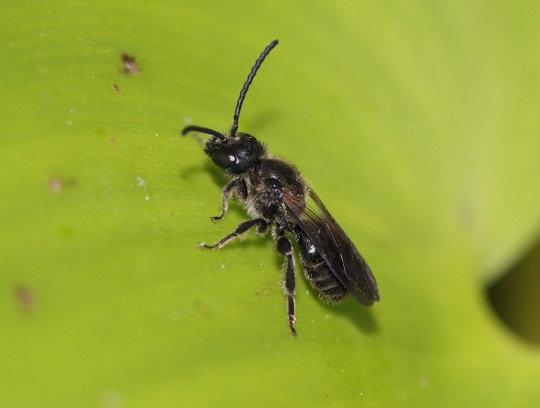
Above: Dufourea novaeangliae, a pickerelweed specialist bee only found in freshwater emergent marshes. Very poorly documented in New Hampshire but easily recognizable and probably all over the place.
Soil also affects what bees live where. Much of northern New England has a highly sandy soil type, which differs vastly from nearby New York and even Vermont (thanks, granite!). Because of this, our plant communities are noticeably different from these states - plants that thrive here are those that do well in harsh conditions, i.e. our poor, sandy, acidic soils. This means oaks and pines, winterberry holly, and a lot of ericaceous plants, aka blueberries, laurels, rhododendrons, partridgeberry, huckleberry, maleberry, leatherleaf, and many others. The understory composition of those forest floor plants is also quite different as well, favoring things like starflower, goldthread, wintergreen, and fringed polygala rather than the squirrel corn, hepatica, and foamflower that need richer, moister soils. Thus, we may not have all of the specialists that need those rich forest flowers, but we have many specialists on those ericaceous plants - and there's a LOT - that are rare in those other states. You probably know just how common lowbush blueberry is in New Hampshire. There's nearly a dozen specialists on blueberry. Sand in general also produces unique bee communities, as many bees (and wasps) are specialized to nest only in sand, thus those are likely more prevalent here than elsewhere.
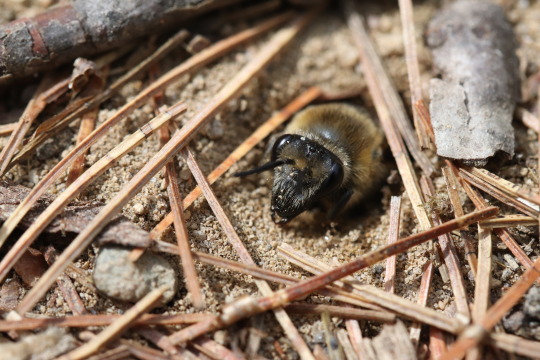
Colletes validus, the blueberry cellophane bee. Nearly absent in New York but likely quite widespread in NH - there's a nice nesting aggregation near my house where I took this photo. As the name implies, they primarily collect pollen from blueberry.

Lasioglossum vierecki, a sandplain specialist. Highly abundant in this specific habitat, but entirely absent anywhere else.
Documenting New Hampshire's Bees
Sadly, New Hampshire is lagging far behind other northeastern states in documenting our bee fauna. As I mentioned, our existing surveys have only covered a small portion of the state and there have been no statewide standardized survey efforts. New York and Vermont have recently completed gigantic, statewide atlases of their bee diversity (linked), and Massachusetts has so much going on I couldn't possibly link it all here, including many grassroots initiatives by towns to go pollinator-friendly, from large-scale habitat restoration to pesticide-free pledges (I recommend signing up for the Mass Pollinator Network newsletter). I do work on Martha's Vineyard, where they're conducting the Martha's Vineyard Atlas of Life, including bee surveys (a great paper by Goldstein and Ascher 2016 details a comprehensive bee survey of the Vineyard, showing all the cool rare bees they have! Such is the way with islands). Not to mention the hub of bee research for this region is in Ontario, at York University. That place has been surveyed to death in comparison to us.
Thanks to the efforts in these neighboring places, we have a pretty good idea of what bees should occur here. But much work needs to be done to actually find them and update decades-old records of species that haven't been formally documented in a very long time. Getting a handle on our bees is very important, across the country and the world, because long-term monitoring is the only way we can track declines. There are a handful of bees that may be extirpated from New Hampshire due to changes in land use, diseases, and pesticides. A big example is the rusty-patched bumblebee (Bombus affinis), which used to occur in NH, but was last seen in the early 90s and is presumed extirpated. Another is that yellow-banded bumblebee, which used to be found throughout the state, but due likely to climate change among other factors, it has receded into the mountains where it is colder and it has less competition from other bumble bee species. It may disappear from the state entirely within the century (this altitudinal range shift has been found in many bumble bees across the world due to climate change). Other bees are becoming more common, like the common eastern bumble bee, while others still are moving north into NH, or have been introduced from Eurasia (like wool-carder bees or rapidly spreading giant resin bee, Megachile sculpturalis).

Giant resin bee, Megachile sculpturalis, introduced to eastern North America in the 1990s. It can outcompete and displace native wood-boring bees like carpenter bees.
So what work is being done in New Hampshire currently to document and protect our bees?
UNH used to be the hub of bee research in the state, due to the Rehan Bee Lab, but even though that lab has moved to Canada, a lot of work still goes on through the Cooperative Extension, including on their research farms where optimal pollinator habitat restoration techniques are being studied. There is some information on their website, such as resources for planting meadows and native plants for NH gardens, though admittedly not all of it is easy to find, and much of the research that's been done in the past few years doesn't appear to be on there at all (unless it's somewhere I'm not seeing).
Lately, much of the attention for pollinator conservation in NH has been directed at our local NH Audubon chapters. In particular, the McLane Audubon Center (Concord) has been undertaking a massive effort to install a native pollinator meadow from seed in the past couple of years, experimenting with different site prep methods. They have been hosting an extensive webinar series which are all available to watch for free, many of which are about our native pollinators.
Apart from this, it's mainly been up to individual nature centers and preserves to create resources and install pollinator habitat, which many have done! But we lack a centralized effort at the state level. There are unfortunately still very few native plant nurseries in NH, and there is no organizational effort to help the public find them. I've been trying over the years to compile a list but many of them are wholesale only. A few dedicated retail nurseries are Bagley Pond Perennials in Warner, Foundwell Farm in Pembroke, and NH Native Perennials in Madison. Wholesale nurseries (meaning you can request them at your regular garden center) are Van Berkum Nursery and American Native Beauties. Otherwise, local nurseries may sell a varying selection of native plants if you hunt for them. You're likely better off finding nurseries in Massachusetts if you live in the southern half of the state - there's many more, or ordering seeds and plants online from the Wild Seed Project, based in Maine, Prairie Moon Nursery, or Ernst Seed. See more at the end of the post.
So how else can we work on documenting our native bees? Until we do a statewide atlas, it comes down largely to citizen science observations. New Hampshire residents are strongly encouraged to record bee sightings to websites like iNaturalist, Bumble Bee Watch, Beecology, and BugGuide. I'm a reviewer on three out of four of these sites so if you post in New England I'll likely see it. While a lot of our native bees cannot be identified from photos, even good ones, plenty can, including some rare and specialized species, making it valuable to go out and look for them in likely habitat, or even just to document what's in your yard.
You can encourage more species of bees to your yard by planting native wildflowers, shrubs, and trees. Keystone species in our area include goldenrods, milkweeds, black cherry trees, willows (not weeping willow), red maple, blueberries, asters, brambles (e.g., black raspberries), shrubby dogwoods, Joe-Pye weeds, sumac trees, wild strawberry, serviceberry, and many others. To support butterflies and moths, and by extension birds, the best thing you can plant is an oak tree, as they support over 500 species of caterpillar in our region. It's also great to plant native grasses, like little bluestem, purple lovegrass, poverty oatgrass, and panic grass, that thrive on our poor soils, instead of large turfgrass lawns that do not do well in these conditions. New Hampshire lawns rarely look healthy! A native lawn of wild groundcovers, forest plants, moss, ferns, sedges, or the above grasses would do much better.
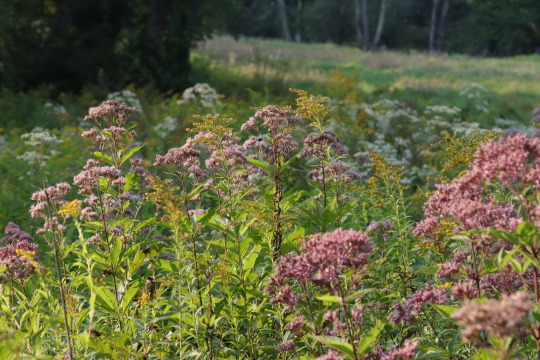
A wet meadow in south-central New Hampshire, featuring Joe-Pye weed, goldenrods, and asters.
Further Resources
In addition to the links throughout this post, there are many more resources to learn about pollinators and native plants in our region.
Online:
Grow Native Mass - a wealth of resources
Wild Seed Project - another wealth of resources
Vermont Wild Bee Survey - user-friendly guide of Vermont's bees
Cornell Danforth Lab; Creating a Garden for Specialist Bees - comprehensive guide for supporting our region's often rare and imperiled specialists
UMass Dartmouth Gegear Lab - resources on supporting locally imperiled bees
Xerces Society - ample resources on establishing pollinator habitat in their Resource Center and Publications Library
GoBotany - user-friendly key for identifying New England plants
Landscape Interactions - behind some of the region's largest and most comprehensive pollinator corridor planting plans, mostly in Massachusetts. Download their master plan documents for free and see how municipalities are implementing these designs.
Heather Holm's website - lots of plant lists and info sheets for native bees, wasps, and plants (some are outside the northeast)
Pollinator Pathway - a ton of broadly applicable information
Bees of New York - great profiles on many northeastern bees
Homegrown National Park - put your native yard on the map and learn more about plants to support the most species
Print:
Bringing Nature Home, by Doug Tallamy (and any of his other books)
Pollinators of Native Plants and Bees: An Identification and Native Plant Forage Guide, by Heather Holm (and any of her other books)
The Northeast Native Plant Primer, by the Native Plant Trust
Deer-Resistant Native Plants for the Northeast, by Ruth Clausen and Gregory Tepper
... plus many others that I cannot all name here. Check your local Audubon gift shop, Barnes and Noble, Toadstool Bookshop, or nature center to find these regionally specific books. One last great book is The Nature of New Hampshire, by Dan Sperduto and Ben Kimball, which covers every natural community in the state. A must-have for lovers of our good old granite state.
I hope this sated your curiosity! And I hope this can be of use to many of you who live in northern New England. As always, feel free to drop me a line anytime on here if you have questions or want to chat about our native pollinators. All photos in this post are my own. Now go out and find some bees!
#tauriel-of-moondoor#bees#pollinators#new england#new hampshire#native bees#wildflowers#i may or may not have spent five hours writing this#but it's worth saying#sorry for posting at 4am but that's when i finished writing it lol#i will reblog again tomorrow#your local pollinator ecologist speaks
26 notes
·
View notes